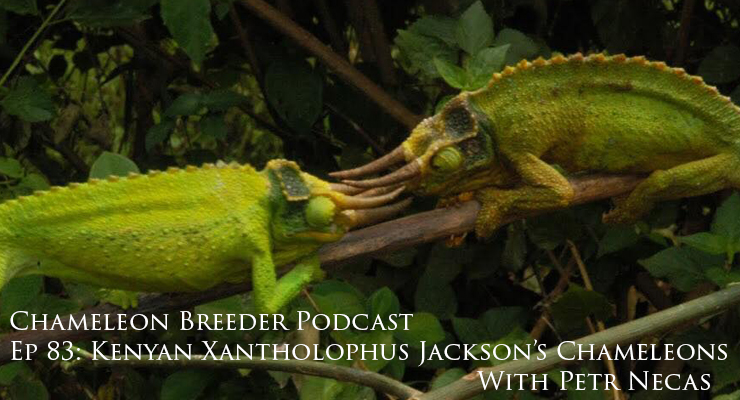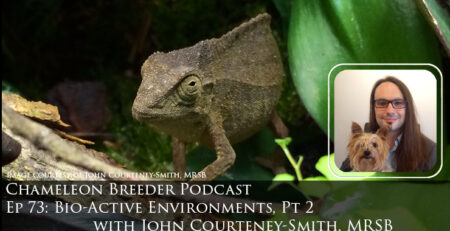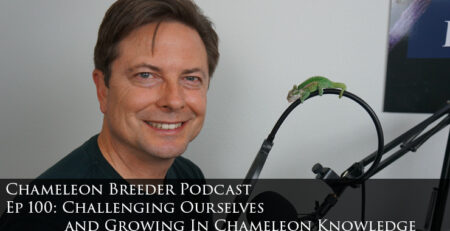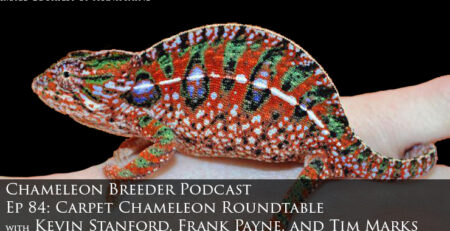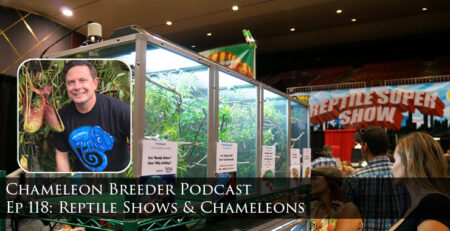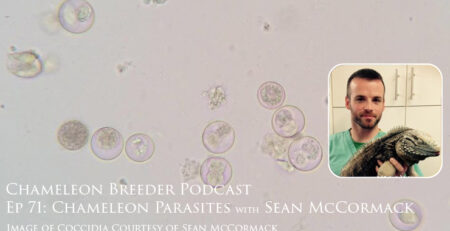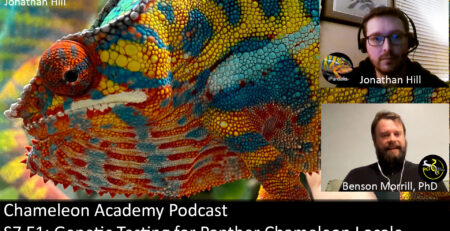Ep 83: Kenyan Xantholophus Jackson’s Chameleons
In the United States, the Large xantholophus Jackson’s Chameleons we see are almost all from a feral population on Hawaii. But this magnificent chameleon originated in Kenya, Africa. The newly started Kenyan Xanth Project is spearheading the effort to bring back the founder genetics. In this episode we learn about the natural environment of Trioceros jacksonii xantholophus, the yellow-crested Jackson’s Chameleon, from world renown chameleon expert and author, Petr Necas who is, at the moment of this episode release, in Kenya studying them in the wild.
The Kenyan Xanth Project
Dear Chameleon Community,
I, like many people, have long had a passion for the Yellow Crested Jackson’s Chameleon (Trioceros jacksonii xantholophus) – the largest of the three recognized subspecies. As most of you know, almost all (if not all) of our xantholophus in captivity is from a feral population on Hawaii. This population is, unfortunately, entirely from a handful of individuals that escaped in 1972. Beautiful as they are, the resulting inbreeding situation has resulted in smaller animals and thinner/shorter/directionally challenged horns. The inexpensive Hawaiian animals ensure that a more expensive import from Kenya will not happen under normal conditions. Thus a whole generation of chameleon keepers do not know what original Jackson’s Chameleons are like and our captive breeding efforts are with 46 years of inbred animals. I would like to change that.
Steve McNary of Chameleons International has the right contacts in Kenya to make this happen. Bringing in relatively expensive Xanths is not really a sound business move for anyone, but Steve has committed to me that if I could generate enough interest he would use his contacts and facilities to make this happen.
Thus I would like to propose a community project. I would like to gather enough interest to bring in between 100 to 200 individuals. This brings in enough diversity that it can be a meaningful project. I come to you like this because this is not a financial investment. This is a passion project. Anyone joining me in this will run into the same “I can buy it for half as much over here!” response from the general reptile public. You will NOT make money by being part of this project. We will be doing this because we know that the health of the Jackson’s Chameleon in captivity is at stake and we are doing this out of love for our chameleons.
The Vision.
Our intention is that healthy Kenyan Xanth blood becomes the expected standard for people searching for a Jackson’s Chameleon. More and more, keepers are asking where they can find a captive born baby. I would like to educate the community so that they seek out Kenyan blood and are willing to pay the higher price it takes to offer healthy captive bred specimens. Kenyan Xanths are genetically diverse, will grow larger, and have more impressive horns. There is a visible difference in these animals and it is worth replacing our view of what a Jackson’s Chameleon is with the true Kenyan specimens.
Who can join?
Anyone who understands the value of bringing in fresh genetics and wants a meaningful project within the chameleon community can join. Of course, there is no interview process so you can come in with any motivation you choose, but the ones that will be happy with this project are lovers of the Jackson’s Chameleon and those who enjoy having a close knit community of fellow breeders.
How do we do this?
I will need to get enough people on board to justify a shipment. I have about two to three weeks to accomplish this. Each animal will be $100. The import would happen mid to late March if we make our numbers.
Next Steps?
If you are interested and would like to learn more, please respond here and I’ll answer all questions. I have started a Facebook Group “Kenyan Xanth Project” where I will be posting updates and answering questions.
Transcript (more or less)
Good morning chameleon wranglers. Today we are discussing the Yellow-crested Jackson’s Chameleon, Trioceros jacksonii xantholophus, and its interesting history. If you started in chameleons in the 90s or later, the probability is high that you started with a Veiled Chameleon. But if you started in the 70s chances are you started with a Jackson’s Chameleon from Kenya. As a boy in the 70s I remember it being a nugget of treasure everything I learned in a book or magazine about the existence of another species of chameleon. And, no, anoles did not count! (That’s a joke for the old timers). The prevalence of Jackson’s chameleons in the formative years is significant because it helps to understand what a great deal of our captive husbandry, in the US at least, was based. If the predominantly imported chameleon in the 70s was Furcifer lateralis, the carpet chameleon, and the epicenter of the dissipation of US chameleon knowledge was in New York instead of Southern California do you think we would have had a couple decades of strict adherence to screen cages? It is interesting how much makes sense when the history is known. Today’s historical journey makes a stop on the Hawaiian island of Oahu in 1972 where a pet store owner, happy with how quickly his first 12 Jackson’s Chameleons sold out, obtained legal permits to bring in another several dozen Jackson’s Chameleons from Kenya. One source uses the number 36. I cannot find official records, but, for this story, only the magnitude is important. As the chameleons were weak and dehydrated he decided to let them recover on the trees in his backyard. On one hand, the natural sun, shade, and water from rain or sprinklers was the absolute best way to allow them to recoup their strength. On the other hand, as any of you who have turned your back on a chameleon in a tree know, chameleons tend to wander. The pet store owner reportedly returned to collect his chameleons to find that the party was over and everyone had gone home – to their new home in the wilds of Oahu. The Jackson’s Chameleon firmly established itself in Oahu and then through natural means and human help spread to other islands. You can hear about the Jackson’s chameleons in Hawaii in episode 33 where I speak with Mary Lovein who lives in Hawaii amongst these tree dragons.
It is illegal to transport Jackson’s Chameleons to the mainland for the pet trade. This is because we do not want to encourage enterprising individuals to intentionally release any other commercially attractive species to the Hawaiian environment for easy collection and sale later. It is also illegal to bring in any more chameleons into Hawaii. So we have this sizeable population that descended from a handful of chameleons. And thus, over the last 46 years we have had an isolated population and a genetic bottleneck. Though import from Hawaii is illegal, Jackson’s Chameleons have poured into the States and have provided a relatively cheap chameleon for the pet trade. Unfortunately, this has relegated captive breeding to unexpected female pregnancies and one time off experiences. There is no way a breeding program could be sustained for what the general reptile public monetarily values this chameleon. The end result is a flow of inbred Jackson’s Chameleons into our captive collections.
Today I have the honor of speaking with Petr Necas who is a field herpetologist with an extensive background in captive keeping of chameleons. For us this is a gold mine as he is able to speak directly to those of us working to recreate natural conditions. He is the author of a number of books including Chameleons: Nature’s Hidden Jewels which is a cornerstone book in many of our personal libraries. He has observed both the Kenyan and the Hawaiian populations and shares his experiences.
This is extra relevant at the time of this recording as I have started a program to revitalize the captive bloodlines. The Kenyan Xanth Project has been established for passionate chameleon keepers and breeders to bring Kenyan bloodlines back into US captive collections. If you are interested in being part of this project please stick around after the interview and I will give details.
Closing
This episode is especially relevant as I, through the Chameleon Breeder Podcast, have started the Kenyan Xanth Project which is aimed towards bringing the Kenyan genetics of the xantholophus subspecies back into our captive collections. Ideally, we would no longer breeder the Hawaiian locality as that bloodline is weak and there is no way to revitalize it. Bringing in strong bloodlines from the founder population in Kenya is the only way. To this end, I have arranged with Steve McNary of Chameleons International to bring in a shipment from Kenya and am looking to community support for this movement. To be clear, this is a passion project. There is no money to be made here and we are fighting an uphill battle. To replace the cheap Hawaiian imports with more expensive Kenyan animals we will have to build awareness in the community of the value of the fresh genetics enough that the public searches for it and is willing to pay for Captive born babies. I believe with the first round of captive born babies raised up under optimal captive conditions and nutrition we will be able to create that awareness.
There are three ways you can help.
First, If you are listening to this podcast the first week after release in February of 2018 then consider joining this project as a breeder to help make it a success. If you are looking for a worthy community project with chameleons and are not needing there to be a financial component then the Kenyan Xanth Project might be for you. We need breeders and enough of an order to make the very expensive import process worth it. Because of the cheap Hawaiian imports, the general reptile community will not pay the higher prices that Kenyan Xanths require. Chameleon’s International is not doing this as a solid business move. They are doing this because they see the value to the chameleon community. But this means I have to generate enough initial sales to bring in at least 100 chameleons. That is okay with me because it would take about that many to kick start this movement in the US. If you are able to help us reach our initial founder stock goal, please go to the show notes at Chameleonbreeder.com for all the details as to how you can get in on the shipment that is being put together now. The price is $100 per chameleon and the Kenyan Xanth Project Facebook group will provide community support for acclimating, maintaining, breeding of these chameleons.
Second, if you are not comfortable with the acclimation process or with your skills just yet then join the Kenyan Xanth Project on Facebook. The link is in the shownotes. You can go and read all the information shared as the founder breeders discuss everything they are going through, give advice, and work through problems. Very soon there will be captive born babies needing homes and this second wave of breeders is just as important as the first wave. It is the second wave that proves that this project can go beyond just an import. Please note that the captive born babies will be more expensive than imports. They are a result of a breeder acclimating and deparasitizing the adults and implementing a solid husbandry and nutritional regimen. Although no chameleon should be sold before three months of age you can cut corners on some species. Jackson’s are not one of those species. We will have to hold on to them for at least three months. But a captive born born baby will be a joy to raise and it is worth it.
Third, if you are not able to be an initial breeder or even a second wave breeder, you can help with community awareness. Bringing these in and going through all the trouble to set them up to provide fresh bloodlines to the community will fall flat on its face if the community does not see the value in these Kenyan animals. If the price is the ultimate deciding factor and the attitude is that a Jackson’s is a Jackson’s then the community will continue to work with the inbred Hawaiian blood. I am not encouraging any shaming or finger wagging towards anyone! Anytime you want to change something in this world it is more effective to build a better alternative than to spend your energies tearing something else down. The best way to raise awareness is to understand the situation with the bloodlines, share it when people mention breeding, and encourage people newly interested in getting involved with Jackson’s to insist on finding Kenyan captive born babies to work with. We will be keeping records on a special section of the chameleonbreeder.com website as to the breeders we know to be working with Kenyan bloodlines and so there will be a whole support system for those interested in working with Kenyan babies. We will need people who understand the value of what we are doing to be evangelists and explain that value to the steady stream of people who discover chameleons for the first time and show up on social media.
Thank you very much for your support of this podcast and of the chameleon community. Let’s see our community as something we all are building. We can make it what we want. Let’s build something strong.
The Kenyan Xanth Project is a worthy project. We have the full support from the contacts and import structure put in place by Chameleon’s International. We have the advice and experience of Petr Necas to help make this a success. Prominent Facebook groups have helped spread the word. So, if you decide to join us you will be in good company. The shownotes at chameleonbreeder.com will give you all the information you need. So, whether you can participate actively or maybe in the future come on by and watch it happen.

